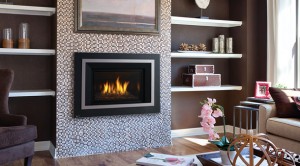Fireplaces remain one of the most requested and sought after home features – across all ages and income brackets. A study by the National Center for Real Estate Research (NCRER) found that 40% of home buyers are willing to pay more for a  home with a fireplace and that having a fireplace increases a home’s value by up to 12%.
home with a fireplace and that having a fireplace increases a home’s value by up to 12%.
Not all fireplaces are created equally, however. Open hearth masonry fireplaces are an impressive focal point, but most are inefficient and require serious upkeep and maintenance.
One way to modernize an open-hearth fireplace – while adding value to your home – is by installing a fireplace insert. Fireplace inserts are an excellent solution that can make your fireplace more efficient, allow you to switch fuel sources, save time, and avoid the hassle – and expense – of a major fireplace renovation.
What is an insert?
A fireplace insert is still a fireplace: it burns fuel to produce heat. Inserts, however, differ from open hearth fireplaces in that they operate using closed system combustion; in a closed system, less heated air is lost up the chimney and the fireplace can more efficiently heat a home. According to the Hearth, Patio, and Barbecue Association (HPBA), installing a fireplace insert to an existing open-hearth fireplace can help reduce energy bills by as much as 40 percent.
Types of inserts
There is no one single size or style of insert. Instead, there is a wide variety of fireplace inserts to match the aesthetics of your home – as well as meet your heating needs.
Choosing the fuel source is often the most difficult choice when picking a new fireplace insert. Wood inserts remain popular as many homeowners want the look and feel of a real, wood-burning fire. Likewise, wood is considered a green fuel source; many are surprised to learn that burning wood is carbon neutral as trees over their lifetime absorb the same amount of carbon dioxide and the fire produces.
Gas is an equally popular fuel choice for fireplace inserts. Gas inserts provide heat at the press of a button with little cleaning or maintenance. While less environmentally friendly, gas is an inexpensive fuel source that provides consistent and controllable heat.
Three benefits of installing a new insert
There are a number of benefits to installing an insert.
1. Better efficiency. Open-hearth fireplaces tend to be inefficient and lose lots of heat up the chimney. Inserts with closed-circuit combustion, however, are significantly more efficient.
2. Fewer emissions. Because open-hearth fireplaces are individually built, their emissions cannot be regulated or controlled; this leads to open-hearth fireplaces being considered as a major cause of air pollution. Inserts of all fuel sources must be regulated, tested, and certified by the EPA. Minimum standards that produce significantly less particulate emissions must be met in order for an insert to be sold.
3. Avoid masonry repairs. A damaged fireplace must be repaired before it can be safely used. Some masonry repairs can be avoided, however, by installing a new insert. Because inserts can be installed into existing fireboxes, a flue resizing may be all that’s needed to begin enjoying the new fireplace.
A fireplace insert is an easy to install, energy-efficient way to upgrade your existing open-hearth fireplace. For more information on the benefits of fireplace inserts, contact Jack Pixley Sweeps today!
